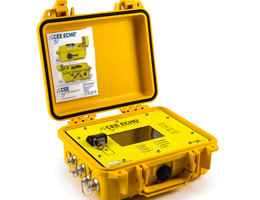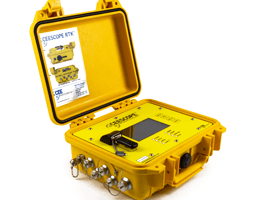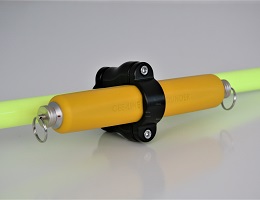The CEE HydroSystems Advantage – “Any Boat Anywhere”
CEE HydroSystems single beam echo sounders are compact, rugged and waterproof units offering the combination of exceptional sonar performance with maximum convenience. By using the latest modern microprocessors, an echo sounder no longer has to be large and impractical to offer survey-grade accuracy. With several built-in GNSS and GPS options from sub-meter to precise RTK, the latest CEESCOPE™ redefines the quality standard for shallow water, personal watercraft, or unmanned USV hydrographic surveying.
The goal of CEE HydroSystems is to maximize survey productivity by simplifying the user experience, and providing resilient and rugged solutions. Instead of spending time on cables, configuration, and equipment setup CEE customers just get to work and start surveying. CEE products are relied upon worldwide in some of the most remote and harsh environments being surveyed.
Single Beam Echo Sounders Comparison Matrix
CEE HydroSystems single beam echo sounders offer a wide range of available features and options such as Bluetooth or Wi-Fi connectivity, internal recording, full water column echogram, rechargeable internal battery power, dual frequency transducers and advanced built-in GNSS and GPS receivers. All echo sounder systems offer no-compromise survey grade ping rates of 10-20 Hz. The CEE-LINE™ is the smallest and lightest survey grade dual frequency echo sounder available. The CEEPULSE™ is a remarkably easy to use “black box” echo sounder with astonishing shallow water bottom tracking ability. The CEE ECHO™ and CEESCOPE™ represent the ultimate blend of performance and convenience for professional hydrographic surveyors.
| Product | Echo Sounder | Maximum Depth | Ping Rate | GPS / GNSS | Bluetooth | Internal Battery | Data Logging | Echo Envelope |
| CEE-LINE™ 100 | 200kHz | 100m | 10Hz | ✘ | ✘ | ✘ | ✘ | ✘ |
| CEE-LINE™ 200 | 200/33kHz | 100m | 10Hz | ✘ | ✘ | ✘ | ✘ | ✘ |
| CEE ECHO™ 100 | 200kHz | 200m | 20Hz | ✘ | ✔ | ✔ | ✔ | ✔ |
| CEE ECHO™ 200 | 200kHz & 24/33kHz | 200m | 20Hz | ✘ | ✔ | ✔ | ✔ | ✔ |
| CEESCOPE™ 100 | 200kHz | 200m | 20Hz | ✔ | ✔ | ✔ | ✔ | ✔ |
| CEESCOPE™ 200 | 200kHz & 24/33kHz | 200m | 20Hz | ✔ | ✔ | ✔ | ✔ | ✔ |
Data Acquisition and Software
Single beam echo sounders from CEE HydroSystems are designed to work with all industry standard hydrographic data acquisition packages such as HYPACK®, QPS QINSy, Trimble HYDROPro, and Eye4Software Hydromagic. Software drivers to display and collect the High Definition full water column digital echo envelope from the CEESCOPE™ and CEE ECHO™ are available. This results in an unparallelled real time view of bathymetry from a portable single beam echo sounder.
Hydrographic Surveying with Single Beam Echo Sounders (SBES)
Single beam echo sounders (SBES), also known as depth sounders or fathometers determine water depth by measuring the travel time of a short sonar pulse, or “ping”. The sonar ping is emitted from a transducer positioned just below the water surface, and the SBES listens for the return echo from the bottom. In reality, the sonar energy will be reflected by anything that may be in the path of the sound – fish, debris, aquatic vegetation and suspended sediment.
Hydrographic survey grade single beam echo sounders are able to provide accurate bottom depths by distinguishing the real bottom from any spurious signals in the returned echo. True survey-grade hydrographic single beam echo sounders record a digital water column echogram or echo envelope, that provides a graphical representation of the return echo. Historically this information was presented on a paper chart recorder using thermal paper to provide the surveyor with a means to qualify sounding accuracy.
SBES may use various different sonar frequencies; typically 200 kHz is used in shallow water under 100m. As the attenuation of sound in water decreases at lower frequencies, 24-33 kHz is commonly used for deeper water surveys. Often, two frequencies are combined for convenience into a single dual frequency transducer, eg 33/200 kHz. For surveys when suspended particulates are very high, usually when dredging is taking place, the low frequency sonar is able to penetrate the thick resuspended layer and measure the undisturbed hard bottom beneath.
Transducers may be selected with different beam widths, which determines the size of the ping footprint on the bottom. Narrower beam transducers provide a smaller ensonified area and therefore present a depth measurement at a more discrete point under the survey vessel. To determine the exact position of bottom features, narrower beam width transducers are desirable. Inexpensive depth sounders may offer a very wide beam width, presenting a low potential for accurate depth measurement. Lower frequency transducers typically have a wider beam width than high frequency options; the transducer needs to be larger to generate a directional beam as the frequency decreases.
Single beam echo sounders offer significant cost savings compared to multibeam echo sounder systems and are especially useful in very shallow water, under 5-10m depth. Results from single beam echo sounders are easier to interpret, far less time-consuming to edit, and the SBES equipment may be operated by less experienced personnel.
CEEDUCER™, CEEDUCER PRO™, and CEESTAR™ Legacy Single Beam Echo Sounders
The CEE range of single beam echo sounders supplied by Bruttour International world-wide include the CEEDUCER™, CEEDUCER PRO™, and CEESTAR™. These single and dual frequency single beam hydrographic survey systems – available with built-in GPS (CEEDUCER™ / CEEDUCER PRO™) or as a standalone echo sounder (CEESTAR™) have been replaced by the latest CEE HydroSystems echo sounders. The older units remain supported by CEE HydroSystems.




